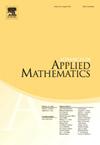Coefficients of the Tutte polynomial and minimal edge cuts of a graph
IF 1.3
3区 数学
Q3 MATHEMATICS, APPLIED
引用次数: 0
Abstract
Let G be a -edge connected graph with order n and size m. From a general result on the coefficients of polymatroid Tutte polynomial, Guan et al. (2023) [16] derived that where is the Tutte polynomial of G and . Recall that the coefficients of have many combinatorial explanations, including spanning trees, parking functions, superstable configurations (or recurrent configurations) of the Abelian Sandpile Model (ASM), and so on. Here we find that the above result has a simple and direct proof in terms of the superstable configurations of ASM. Motivated by this, in this paper, by constructing mappings between different sets, we first establish a relationship between non-superstable configurations and minimal edge cuts of G, then we generalize the above result from to . In precise, where denotes the set of all minimal edge cuts with j edges. Thus, our results provide a new combinatorial explanation for some coefficients of in terms of minimal edge cuts.
图的图特多项式系数和最小切边
设G为一个阶数为n、大小为m的(k+1)边连通图。Guan et al.(2023)[16]从一个关于多矩阵Tutte多项式系数的一般结果推导出[yg−i]TG(1,y)=(n+i−2n−2),0≤i≤k,其中TG(x,y)是G的Tutte多项式,G =m−n+1。回想一下,TG(1,y)的系数有许多组合解释,包括生成树、停放函数、阿贝尔沙堆模型(ASM)的超稳定构型(或循环构型)等等。在这里,我们发现上述结果在ASM的超稳定组态上有一个简单而直接的证明。基于此,本文通过构造不同集合之间的映射,首先建立了非超稳定组态与G的最小切边之间的关系,然后将上述结果从0≤i≤k推广到0≤i<;3(k+1)2。精确地说,[yg−i]TG(1,y)=(n+i−2n−2)-∑j=k+1i(n+i−j−2n−2)|ECj(G)|,0≤i<3(k+1)2,其中ECj(G)表示所有具有j条边的最小边切割的集合。因此,我们的结果为TG(1,y)的一些系数提供了一种新的组合解释。
本文章由计算机程序翻译,如有差异,请以英文原文为准。
求助全文
约1分钟内获得全文
求助全文
来源期刊

Advances in Applied Mathematics
数学-应用数学
CiteScore
2.00
自引率
9.10%
发文量
88
审稿时长
85 days
期刊介绍:
Interdisciplinary in its coverage, Advances in Applied Mathematics is dedicated to the publication of original and survey articles on rigorous methods and results in applied mathematics. The journal features articles on discrete mathematics, discrete probability theory, theoretical statistics, mathematical biology and bioinformatics, applied commutative algebra and algebraic geometry, convexity theory, experimental mathematics, theoretical computer science, and other areas.
Emphasizing papers that represent a substantial mathematical advance in their field, the journal is an excellent source of current information for mathematicians, computer scientists, applied mathematicians, physicists, statisticians, and biologists. Over the past ten years, Advances in Applied Mathematics has published research papers written by many of the foremost mathematicians of our time.
 求助内容:
求助内容: 应助结果提醒方式:
应助结果提醒方式:


